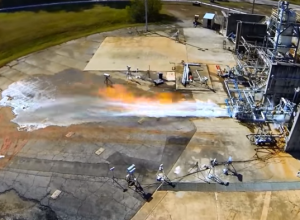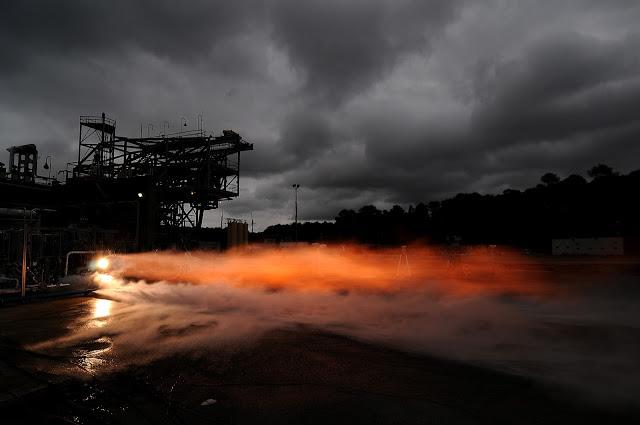If you’re following 3D printing news at all, you probably know that NASA has been working towards building an entirely 3D printed rocket, and they’re getting closer, one part at a time. News about successful part tests have been coming out at pretty regular intervals during the year, with the latest being a test of a 3D printed gas generator engine component. Now, NASA has carried out the most comprehensive test yet, and it shows that they are very close indeed to successfully completing their mission.
It’s one thing to test individual parts, but it’s quite another to test them together. A turbopump, no matter how well it works, doesn’t do anyone much good by itself, after all. The most recent series of tests, carried out in October at Marshall Space Flight Center in Huntsville, Alabama, had some promising results: the individual rocket components do, in fact, work pretty well together, and NASA is now three-quarters of the way to completing the first-ever completely 3D printed rocket engine.
“We manufactured and then tested about 75 percent of the parts needed to build a 3-D printed rocket engine,” said project manager Elizabeth Robertson. “By testing the turbopumps, injectors and valves together, we’ve shown that it would be possible to build a 3-D printed engine for multiple purposes such as landers, in-space propulsion or rocket engine upper stages.”
In the latest tests, the rocket engine was fired using cryogenic liquid hydrogen and oxygen to produce over 20,000 pounds of thrust, resulting in a pretty impressive, fiery blast:
The prototype isn’t configured exactly the same way as the final engine will be; to allow engineers to have access to all of the parts, they were wired together in a large configuration that won’t match the final product. But the important thing was that they worked the same way that they will in the final product.
“In engineering lingo, this is called a breadboard engine,” said testing lead Nick Case. “What matters is that the parts work the same way as they do in a conventional engine and perform under the extreme temperatures and pressures found inside a rocket engine. The turbopump got its ‘heartbeat’ racing at more than 90,000 revolutions per minute (rpm) and the end result is the flame you see coming out of the thrust chamber to produce over 20,000 pounds of thrust, and an engine like this could produce enough power for an upper stage of a rocket or a Mars lander.”
We’ve discussed the numerous benefits of 3D printing for the manufacture of aerospace components many times already: it dramatically reduces the time and cost required by traditional manufacturing methods, and it allows for less parts altogether. Large parts can be 3D printed in one piece, which is impossible in other forms of manufacturing. The turbopump, for example, required 45% fewer parts than it would have otherwise, and the injector has over 200 fewer parts than a traditionally manufactured one.
“This new manufacturing process really opened the design space and allowed for part geometries that would be impossible with traditional machining or casting methods,” said propulsion designer David Eddleman. “For the valve designs on this engine, we used more efficient structures in the piece parts that resulted in optimised performance.”
 One of the concerns with 3D printing is whether the parts can stand up to the extreme temperatures required of a rocket engine: from 6,000 degrees Fahrenheit to as low as negative 400. In all six of the October tests, the printed components held up admirably. So what’s next? More testing, of course. Future plans include firing the rocket using liquid oxygen and methane, gases that may be present on Mars. And of course, there’s still a quarter of the parts left to 3D print. But NASA is over halfway there, which is amazing.
One of the concerns with 3D printing is whether the parts can stand up to the extreme temperatures required of a rocket engine: from 6,000 degrees Fahrenheit to as low as negative 400. In all six of the October tests, the printed components held up admirably. So what’s next? More testing, of course. Future plans include firing the rocket using liquid oxygen and methane, gases that may be present on Mars. And of course, there’s still a quarter of the parts left to 3D print. But NASA is over halfway there, which is amazing.
If you’re interested in the full materials characterization and performance data on the finished parts, you can request access to NASA’s Materials and Processes Technical Information System (MAPTIS). Discuss this story in the 3D Printed Rocket Engine forum on 3DPB.com. Now here’s a video of Case further explaining the construction of the breadboard engine:
Subscribe to Our Email Newsletter
Stay up-to-date on all the latest news from the 3D printing industry and receive information and offers from third party vendors.
Print Services
Upload your 3D Models and get them printed quickly and efficiently.
You May Also Like
Consolidation in AM: How 2025 Is Shaping the Industry’s New Normal
The first half of 2025 has been marked by a clear shift in the additive manufacturing (AM) industry. Companies are no longer just focused on developing new tech by themselves....
Etsy Design Rule Change Reduces Selection of 3D Printed Goods
Online marketplace Etsy has implemented a rule change requiring all 3D printed goods on the site to be original designs. The update to the site’s Creativity Standards states, ¨Items produced using...
U.S. Congress Calls Out 3D Printing in Proposal for Commercial Reserve Manufacturing Network
Last week, the U.S. House of Representatives’ Appropriations Committee moved the FY 2026 defense bill forward to the House floor. Included in the legislation is a $131 million proposal for...
Transforming From Tourist to Native: Duro CEO Michael Corr Explains Why the Company Rebuilt its PLM Software on AI
In these early innings of the AI boom, many market analysts have expressed concern that AI spend has gotten too far ahead of the technology’s proven ability to deliver significant...

































